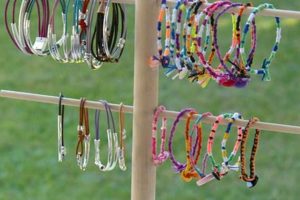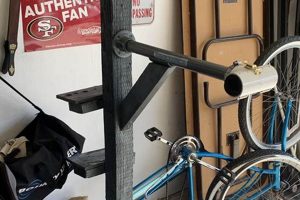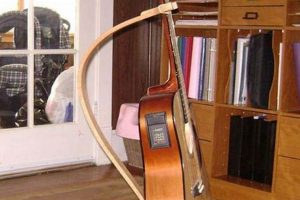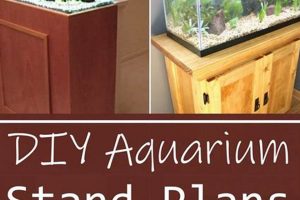A self-constructed support structure designed to bear the weight of a standard 55-gallon aquatic habitat is a project undertaken by aquarists for both functional and aesthetic purposes. These stands offer a platform for the aquarium, ensuring stability and preventing potential structural failures due to the significant weight involved. A customized stand allows for specific design preferences and tailored dimensions, optimizing space utilization and integration within a given environment.
Constructing a custom-built aquarium support offers several advantages. Primarily, it enables cost savings compared to commercially available options. It also allows for design flexibility, enabling incorporation of features such as integrated storage, customized height, and specific aesthetic elements. The creation of a sturdy and visually appealing base contributes to the overall health and safety of the aquatic ecosystem and the surrounding environment, minimizing risks of accidents and maximizing aesthetic appeal.
The following sections will outline crucial considerations for planning and executing such a construction project, including material selection, design principles, step-by-step assembly guidelines, and essential safety precautions. The goal is to empower individuals with the knowledge to create a reliable and visually appealing foundation for their aquatic display.
Construction Considerations for an Aquarium Support Structure
The successful creation of a structurally sound and aesthetically pleasing aquarium support requires careful planning and execution. The following tips highlight crucial elements to consider during the design and construction phases.
Tip 1: Structural Integrity is Paramount: Prioritize load-bearing capacity over aesthetic considerations. The fully loaded weight of a 55-gallon aquarium, including water, substrate, and decor, can exceed 600 pounds. Employ robust construction methods and materials capable of withstanding this weight with a significant safety margin.
Tip 2: Material Selection is Critical: Pressure-treated lumber, solid hardwood, or welded steel are suitable material choices, each offering distinct advantages and disadvantages. Plywood, if used, should be exterior-grade and properly sealed to prevent water damage and structural degradation.
Tip 3: Accurate Measurements and Precise Cuts: Errors in measurements or cuts can compromise the structural integrity and stability of the stand. Double-check all dimensions and use appropriate tools to ensure accurate and consistent cuts.
Tip 4: Secure Fastening Techniques are Essential: Utilize screws, bolts, and wood glue to create strong and durable joints. Avoid nails, as they are more prone to failure under sustained load. Reinforce corners and joints with metal brackets or gussets for added stability.
Tip 5: Leveling is Non-Negotiable: An unlevel stand can place undue stress on the aquarium glass, increasing the risk of cracks or leaks. Use a level to ensure the stand is perfectly level both horizontally and vertically before placing the aquarium on top.
Tip 6: Water Resistance is Imperative: Apply a waterproof sealant or paint to all exposed wood surfaces to protect against water damage and prolong the lifespan of the stand. Consider using a rubber mat or liner between the stand and the aquarium to provide additional protection.
Tip 7: Ventilation is Important: Incorporate adequate ventilation into the design to prevent moisture buildup and mold growth within the stand. This is particularly important if the stand houses filtration equipment or other components that generate heat.
These guidelines emphasize the importance of safety, durability, and longevity in the construction of a support for an aquatic environment. Careful attention to these details will help ensure the successful and safe display of the aquarium.
The subsequent sections will delve into specific design plans and construction techniques for achieving a secure and aesthetically pleasing aquarium setup.
1. Structural Integrity
Structural integrity is a paramount consideration in the context of a self-constructed support for a standard 55-gallon aquarium. The ability of the stand to withstand the considerable weight and stress imposed by a fully loaded tank is non-negotiable. Failure to ensure adequate structural integrity can result in catastrophic consequences, including tank failure, property damage, and potential injury.
- Load-Bearing Capacity
Load-bearing capacity refers to the maximum weight a structure can safely support without failure. A 55-gallon aquarium, when filled with water, substrate, and decorations, can easily exceed 600 pounds. The support must be designed and constructed to handle this weight with a substantial safety margin. Insufficient load-bearing capacity can lead to sagging, warping, or complete collapse of the stand.
- Material Strength and Stiffness
The materials used in constructing the support directly influence its structural integrity. Wood, steel, and concrete are common choices, each possessing distinct strength and stiffness characteristics. Softer woods like pine require thicker dimensions and reinforced joints compared to hardwoods like oak or maple. Steel offers superior strength but requires welding skills and rust protection. Selection of appropriate materials is critical for achieving the desired level of structural integrity.
- Joint Construction and Fasteners
The manner in which the components of the stand are joined together significantly impacts its overall strength. Weak or poorly constructed joints are a common point of failure. Screws, bolts, and glue are preferred over nails, as they provide a more secure and durable connection. Reinforcing corners and joints with metal brackets or gussets further enhances the stand’s ability to withstand stress and prevent racking.
- Stability and Leveling
A stable and level base is crucial for distributing weight evenly and preventing undue stress on the aquarium glass. An unlevel stand can create pressure points, increasing the risk of cracks or leaks. Shimming the base to achieve perfect levelness is essential, and the stand’s design should incorporate features that resist tipping or wobbling. A solid, stable foundation is integral to long-term structural integrity.
The interconnectedness of these facets underscores the importance of a holistic approach to ensuring structural integrity. Proper material selection, sound construction techniques, and attention to detail are essential for creating a support that can safely and reliably bear the weight of a 55-gallon aquarium. Neglecting any of these aspects can compromise the entire structure and lead to potentially devastating consequences.
2. Material Selection
The choice of materials is a foundational decision in the construction of an aquarium support and profoundly influences its structural integrity, longevity, and aesthetic appeal. Careful consideration of material properties is critical to ensure the successful and safe support of a 55-gallon aquatic environment.
- Wood (Dimensional Lumber and Plywood)
Dimensional lumber, such as pine, fir, or hardwoods like oak, provides structural framing. Plywood, particularly exterior-grade, can be used for panels and shelving. Softwoods offer cost-effectiveness but require careful joint construction and may be susceptible to moisture damage. Hardwoods provide superior strength and water resistance but are more expensive. Plywood adds rigidity and surface area, but requires sealing to prevent warping and delamination. The selection depends on budget, desired aesthetic, and construction skill level.
- Metal (Steel)
Steel offers exceptional strength and durability, making it suitable for robust supports. Steel frames can be constructed using welding techniques. However, steel is susceptible to rust and requires protective coatings, such as paint or powder coating. While providing a strong and relatively slim profile, steel construction necessitates specialized equipment and skills.
- Concrete (Blocks and Poured Concrete)
Concrete blocks provide a stable and cost-effective base, particularly for larger aquariums. Poured concrete allows for custom shapes and sizes. Concrete is highly resistant to moisture and provides excellent load-bearing capacity. However, concrete supports are typically heavier and less aesthetically versatile than wood or steel options.
- Moisture Resistance and Treatment
Regardless of the primary material, moisture resistance is a critical factor. Wood requires sealing with waterproof paint or varnish. Steel requires rust-preventative coatings. Concrete benefits from a sealant to prevent efflorescence and moisture wicking. Untreated materials are prone to deterioration, compromising the structural integrity and lifespan of the support. Proper treatment is essential for maintaining a safe and reliable stand.
The selection of materials for an aquarium support is a multifaceted decision involving considerations of strength, durability, cost, aesthetics, and construction expertise. The optimal choice depends on individual preferences and project constraints, but must always prioritize the safe and reliable support of the aquatic environment. Choosing inappropriate material jeopardize the setup.
3. Joint Strength
Joint strength, the capacity of connections between structural members to withstand applied forces without failure, represents a critical factor in the structural integrity of a self-constructed support for a standard 55-gallon aquarium. Inadequate joint strength can lead to catastrophic collapse, underscoring the importance of careful design and execution in their construction.
- Types of Joints and Their Load-Bearing Capabilities
Different joint types, such as butt joints, lap joints, mortise and tenon joints, and miter joints, possess varying load-bearing capacities. Butt joints, the simplest form, are inherently weak and require reinforcement. Lap joints offer increased surface area for bonding, improving strength. Mortise and tenon joints, commonly used in woodworking, provide exceptional resistance to shear forces. Miter joints, while aesthetically pleasing, are structurally weaker than other options and require careful reinforcement. The selection of appropriate joint types, coupled with proper construction techniques, is crucial for ensuring adequate joint strength.
- Fasteners: Screws, Bolts, and Adhesives
The type and quality of fasteners used in joint construction significantly influence their strength. Screws and bolts provide mechanical fastening, distributing forces across a larger area compared to nails. Adhesives, such as wood glue or epoxy, enhance joint strength by creating a continuous bond between surfaces. The combination of mechanical fasteners and adhesives offers the most reliable joint construction. The selection of appropriate fasteners depends on the materials being joined and the anticipated load conditions.
- Reinforcement Techniques: Brackets and Gussets
Reinforcement techniques, such as the use of metal brackets or wooden gussets, can significantly enhance joint strength. Brackets and gussets provide additional support and distribute forces across a wider area, preventing stress concentrations that can lead to failure. Corner brackets are particularly effective at resisting racking forces, which are common in aquarium stands. The strategic placement of reinforcement elements can dramatically improve the overall strength and stability of the structure.
- Impact of Material Properties on Joint Strength
The properties of the materials being joined, such as their density, hardness, and porosity, influence the effectiveness of joint construction. Softer woods require more robust joints and fasteners compared to hardwoods. Porous materials may require special adhesives to ensure proper bonding. Understanding the material properties is essential for selecting appropriate joint construction techniques and ensuring adequate joint strength. The materials being joined must have compatibality.
The factors outlined above collectively determine the overall strength and reliability of joints within the support. Prioritizing appropriate joint types, fastener selection, reinforcement techniques, and material compatibility is paramount in ensuring the safe and long-term support of a 55-gallon aquarium. Failure to do so can compromise the structure’s integrity and lead to potential disasters. Properly built stands prevent stress to the aquarium.
4. Weight distribution
Weight distribution is a fundamental engineering principle critically relevant to the design and construction of a self-made support for a standard 55-gallon aquarium. A 55-gallon tank, when fully stocked, can weigh upwards of 600 pounds. The stand must effectively transfer this load to the floor in a stable and uniform manner to prevent structural failure and ensure the long-term integrity of both the support and the aquarium itself. Uneven distribution concentrates stress, potentially leading to cracking of the aquarium glass or collapse of the stand.
Effective weight distribution necessitates a design that incorporates a robust frame with vertical supports strategically positioned beneath the areas of greatest load. The perimeter of the tank base, for example, should be directly supported by vertical members of the stand. A central support may also be necessary to prevent bowing or sagging in the horizontal frame. Leveling the stand is also critical, as an unleveled stand concentrates weight on specific points, exacerbating stress. Consider a scenario where one corner of the stand is lower than the others. This discrepancy would shift a disproportionate amount of the tank’s weight onto the higher corners, increasing the risk of catastrophic failure. Real-world examples abound where inadequately designed stands have succumbed to the weight, resulting in significant water damage and loss of aquatic life.
In conclusion, weight distribution is not merely a design consideration but a critical factor determining the safety and longevity of a self-constructed aquarium support. Proper design, construction, and leveling techniques are essential for ensuring that the considerable weight of the tank is uniformly distributed across the supporting structure and transferred to the floor. Failure to adequately address weight distribution can have severe consequences, highlighting the practical significance of this understanding for any individual undertaking such a project. Careful planning mitigates potential disasters.
5. Water Resistance
Water resistance is a critical consideration in the design and construction of a self-made support for a standard 55-gallon aquarium. Given the proximity to a substantial volume of water, the stand is inherently susceptible to moisture exposure, which can compromise structural integrity and lead to premature failure. Adequate water resistance measures are, therefore, essential for ensuring the longevity and safety of the aquarium setup.
- Material Selection for Moisture Protection
The choice of materials directly impacts the stand’s ability to withstand moisture. While wood is a common choice due to its aesthetic appeal and workability, it is inherently vulnerable to water damage. Selecting moisture-resistant lumber, such as pressure-treated wood or certain hardwoods like cedar or redwood, can mitigate this risk. Alternatively, using materials like steel or concrete provides inherent water resistance, though they may require additional coatings to prevent rust or efflorescence.
- Protective Coatings and Sealants
Applying protective coatings and sealants provides an additional layer of defense against moisture penetration. Waterproof paints, varnishes, and epoxy coatings create a barrier that prevents water from reaching the underlying material. Sealants should be applied to all joints and seams to prevent water from seeping into the structure. Regular inspection and maintenance of these coatings are necessary to ensure their continued effectiveness.
- Ventilation and Airflow
Proper ventilation and airflow are essential for preventing moisture buildup within the stand. Enclosed spaces can trap moisture, creating a breeding ground for mold and mildew, which can further degrade the structural materials. Incorporating ventilation openings or using fans to circulate air can help to reduce moisture levels and promote drying. This is particularly important if the stand houses equipment that generates heat, as warm air can exacerbate moisture problems.
- Prevention of Spills and Leaks
While water resistance measures are crucial, preventing spills and leaks is equally important. Placing a waterproof mat or liner between the aquarium and the stand can protect the underlying structure from accidental spills. Regularly inspecting the tank and plumbing for leaks and addressing them promptly can minimize the risk of water damage. Implementing these preventative measures can significantly extend the lifespan of the stand.
In conclusion, water resistance is an indispensable element in the design and construction of a self-built aquarium support. The selection of appropriate materials, the application of protective coatings, the provision of adequate ventilation, and the implementation of preventative measures are all essential for ensuring the long-term durability and safety of the stand. Neglecting these considerations can lead to structural degradation, posing a risk to the aquarium, its inhabitants, and the surrounding environment. Prioritizing water resistance is, therefore, a fundamental aspect of responsible aquarium keeping.
6. Accurate Dimensions
In the context of self-constructing a support for a standard 55-gallon aquarium, precise measurements and adherence to dimensional specifications are not merely aesthetic considerations but critical factors that directly influence structural integrity, stability, and overall safety. Deviations from accurate dimensions can compromise the stand’s load-bearing capacity, leading to potential failure and catastrophic consequences.
- Impact on Load Distribution
Accurate dimensions ensure uniform weight distribution across the stand’s structural members. Inaccurate measurements can result in uneven load bearing, concentrating stress on specific points and increasing the risk of cracking or collapse. For example, if the support’s top frame is not perfectly rectangular, the aquarium’s weight will be unevenly distributed, potentially causing stress fractures in the glass.
- Influence on Stability
Precise dimensions are essential for maintaining the stand’s stability. A stand with inaccurate dimensions may be prone to wobbling or tipping, particularly when subjected to the weight of a filled aquarium. Such instability can place undue stress on the aquarium’s seams and increase the risk of leaks or catastrophic failure. Furthermore, an unstable stand can pose a safety hazard to individuals and property in the vicinity.
- Effect on Joint Integrity
Accurate dimensions facilitate the proper construction and alignment of joints, which are critical for the stand’s structural integrity. Inaccurate measurements can lead to misaligned joints, compromising their strength and reducing their ability to withstand load. For instance, if the components of a mortise and tenon joint are not precisely sized, the joint will be weakened and prone to failure under stress.
- Relationship to Aquarium Fit and Support
Accurate dimensions ensure a proper fit between the aquarium and the stand, providing full and uniform support for the tank’s base. Deviations from accurate dimensions can result in gaps or uneven contact between the aquarium and the stand, creating pressure points that can damage the glass. A properly dimensioned stand provides a stable and level surface that evenly distributes the aquarium’s weight, minimizing stress and maximizing safety.
In summary, achieving accurate dimensions is paramount to the successful construction of a reliable aquarium support. Ignoring this factor can undermine the structural integrity of the stand, endanger the aquarium, and create potential safety risks. Therefore, meticulous attention to detail and the use of precise measurement techniques are essential for any individual undertaking such a project.
7. Stability
Stability, in the context of a self-constructed support for a standard 55-gallon aquarium, transcends a mere aesthetic consideration; it represents a critical engineering parameter directly impacting the safety and longevity of the entire aquatic ecosystem. A stable platform is essential to prevent catastrophic failure and ensure the well-being of the aquarium inhabitants.
- Leveling and Load Distribution
Precise leveling is paramount to achieving uniform load distribution across the support structure. An unleveled base concentrates weight on specific points, creating stress gradients within the aquarium glass and potentially leading to cracking or leaks. Furthermore, uneven weight distribution can compromise the stand’s structural integrity, increasing the risk of collapse. Shimming techniques and precise measurements are essential for achieving a perfectly level and stable base.
- Resistance to Tipping and Wobbling
A stable support must resist tipping or wobbling forces, which can be induced by external factors such as accidental bumps or seismic activity. The stand’s design should incorporate a wide base of support and a low center of gravity to enhance its resistance to these forces. Bracing and cross-members can further increase stability by providing additional rigidity and preventing lateral movement. Real-world incidents involving unstable stands demonstrate the potential for significant water damage and loss of aquatic life.
- Joint Integrity and Rigidity
The rigidity of the joints connecting the stand’s structural members directly influences its overall stability. Weak or poorly constructed joints can allow for excessive movement and deformation, compromising the stand’s ability to support the weight of the aquarium. Strong, well-executed joints, using appropriate fasteners and adhesives, are essential for creating a stable and rigid frame. Metal brackets or gussets can provide additional reinforcement and prevent racking.
- Material Selection and Dimensional Stability
The choice of materials and their dimensional stability play a significant role in the stand’s long-term stability. Materials prone to warping or shrinking can compromise the structural integrity and stability of the stand over time. Selecting dimensionally stable materials, such as hardwoods or steel, and properly sealing wood to prevent moisture absorption can help to maintain the stand’s stability over its lifespan.
These interwoven aspects highlight the central role of stability in the design and construction of a reliable stand for an aquatic enclosure. A structurally unsound stand can easily topple and pose harm to all equipment surrounding it.
Frequently Asked Questions
The following questions address common concerns and misconceptions regarding the construction of a support for a standard 55-gallon aquarium. The information is intended to provide clarity and guidance for individuals undertaking such a project.
Question 1: What is the minimum acceptable load-bearing capacity for such a structure?
A support for a 55-gallon aquarium must, at a minimum, withstand a static load of 600 pounds. However, it is prudent to design for a significantly higher capacity, incorporating a safety factor of at least 1.5 to account for dynamic loads and potential stress concentrations. This yields a recommended minimum design capacity of 900 pounds.
Question 2: Is plywood suitable for constructing the entire support?
Plywood can be incorporated into the design, but its use as the sole structural material is generally discouraged. Exterior-grade plywood, properly sealed, can be used for panels and shelving. However, the primary load-bearing elements should be constructed from solid wood or steel to ensure adequate strength and rigidity.
Question 3: What is the recommended spacing for vertical support members?
The spacing of vertical support members depends on the design and materials used. As a general guideline, vertical supports should be spaced no more than 24 inches apart. For particularly heavy aquariums or when using softer woods, closer spacing may be necessary. The goal is to minimize deflection and ensure even weight distribution.
Question 4: How critical is it to level the support before placing the aquarium?
Leveling the support is of paramount importance. An unleveled stand can create stress concentrations in the aquarium glass, increasing the risk of cracks or leaks. Furthermore, an unleveled stand can compromise the stability of the entire setup. Precise leveling, using shims as needed, is essential.
Question 5: What type of sealant should be used to protect wood from water damage?
A high-quality waterproof sealant, specifically designed for wood, is recommended. Epoxy-based coatings and marine-grade varnishes offer excellent protection against moisture penetration. The sealant should be applied to all exposed wood surfaces, including edges and joints, following the manufacturer’s instructions.
Question 6: Is ventilation within the support structure necessary?
Ventilation is beneficial for preventing moisture buildup and mold growth within the stand, particularly if the support houses filtration equipment or other heat-generating components. Providing ventilation openings or using a small fan to circulate air can help to maintain a dry environment and prolong the lifespan of the structure.
In summation, the information provided serves to clarify crucial aspects of building a sturdy support. The focus is on practical considerations that can significantly impact stability. Prioritize safety by adhering to stringent methods.
The next article section will deal with general tips.
diy 55 gallon fish tank stand
This exploration has underscored the critical factors in constructing a durable and reliable support for a standard 55-gallon aquarium. Structural integrity, material selection, joint strength, proper weight distribution, water resistance, accurate dimensions, and overall stability are paramount. Adherence to these principles ensures the safe and long-term housing of the aquatic environment.
The information presented should empower aquarists to make informed decisions in the construction of a self-built aquarium base. Prioritizing safety, structural integrity, and attention to detail are essential for a successful build. Continuous vigilance and diligent upkeep are recommended to safeguard the aquarium and its surroundings.







